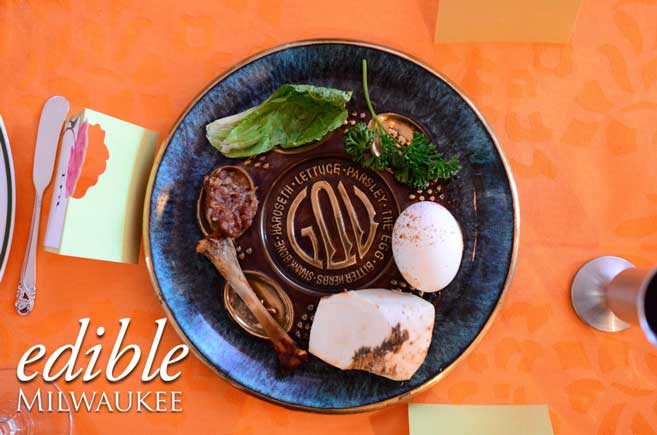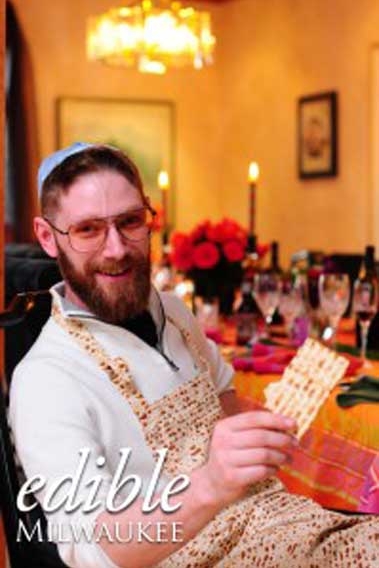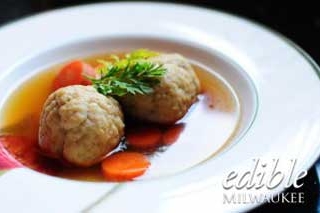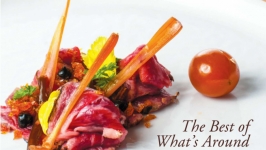The Seder
In the Jewish tradition, it is considered a mitzvah—a good deed—to invite people of other faiths to attend the Seder dinner. The Seder marks the beginning of Passover, an eight day celebration of the Israelites’ liberation from slavery in Egypt. The story of the exodus has been told and re-told over multiple generations (and diaspora) at this ritual feast, and is accompanied by symbolic foods, gestures, literature, and traditions. The messages, though told in one religious context, are broad enough that anyone, regardless of creed, can find meaning in them.
Micah Kaufman, currently the executive chef of the Milwaukee Art Museum, welcomed us last year into his family’s home, owned by aunt and uncle Ira and Nancy Kaufman in Mequon. The Kaufmans’ mitzvah was twofold—they educated both our minds and our palates. The daylong feast featured a diversity of recipes drawn from both branches of Judaism: Ashkenazi and Sephartic. (Ashkenazim descend from the Jews of Central and Eastern Europe, centered in Germany, and Sepharti from Portugal, Spain, North Africa, and the Middle East.) The culinary choices at the Kaufman’s home reflected the family’s travels, imbuing the meal with flavors as bright as the storytelling. Micah says proudly, “My aunts and uncle are world travelers, my mother is a world traveler. I travel. We try to marry contemporary experiences to historical traditions. We want the familiar—the things that must exist—the same matzo ball soup that grandmother made. At the same time, we celebrate the new experiences we’ve gained in the year, recognizing the way we’ve changed, while maintaining the integrity of our traditions.”
Matzo ball soup, though enhanced by a rich, homemade chicken broth and fresh vegetables, at the Kaufman’s Seder will always start from a box. It’s about accepting traditions, without judgment, regardless of its origin. Laughing, Micah quips, “Manischewitz will cater your entire Seder, if you want. If grandma used boxed matzo meal, then that’s what we do.” Manischewitz also makes a ubiquitous jarred Gefilte fish, another staple of Jewish cuisine. The Kaufmans opted to make theirs fresh, using a Mediterranean recipe Nancy’s friend had emailed four years back—a mixture of fresh perch, pike, and whitefish, and topping it simply, with olive oil.
“It begins with Nancy,” Micah asserts. “When I’m in Nancy’s kitchen, I am the sous chef. She’s the boss. Usually, she’s drawn ideas throughout the course of the year as to what she wants to do. I use my skills as a chef to complement what she wants.” Nancy’s Seder menu pulled out all the stops: roast lamb with Middle Eastern spice and saffron. Roasted potatoes. Cauliflower salad with lemon, quinoa, and sumac. Deviled eggs with neon yellow yolks. Hot fried falafel with hummus and Harissa. Matzo ball soup. Gefilte fish with freshly grated horseradish. For dessert, strawberry vanilla torte, along with fruit slices, and chocolate covered frogs and locusts (you guessed it, the Pharaoh’s plagues in candy form).
The Seder Plate
On top of the ke’ara, or Seder plate, sit six symbolic foods, each illustrating a part of the Passover story. Karpas, a vegetable like celery or parsley, is eaten first as an appetizer—dipped into salt water, the taste reminds participants of the bitter tears shed by Israelites as they prepared to leave their homes for the desert. Maror and chazeret, two types of bitter herbs, usually horseradish or Romaine lettuce, call to mind the difficulties and pain endured by the Israelites under Egyptian rule. The next item is charoset, a dried fruit and nut paste, resembling the mortar used by slaves to build. Beitzah, a hard-boiled egg, and Zeroa, a roasted goat or lamb bone, the Pesach sacrifices offered at the Temple of Jerusalem.
Accompanying the Seder plate is a stack of three matzot, symbolic of the pieces of unleavened bread eaten after the Israelites were set free. Says Micah,“Food is the symbolism, radiating outward from the Seder plate. The communal experience of sharing in hospitality is very universal. It’s a way of sharing abundance and a collective experience. We satiate our hunger, we satiate our thirst. We satiate our desire to be free.” The Haggadah takes participants through that journey from bondage to freedom.
How Is This Night Different?
Throughout the meal, a leader—in the Kaufman house, it was Ira—reads from the Haggadah, a book outlining the order of the Passover Seder. It begins with the Kiddush, recitation of a blessing over the wine to sanctify the holiday. Those present participate, following along, eating, drinking, reading sections, echoing, and singing when indicated. The experience is meant to be engaging, exciting and educational for both young and old. Particular emphasis is placed on keeping the kids involved, first by encouraging them to ask, “How is this night different from all other nights?” For the adults, Seder is punctuated by four (sometimes five, sometimes more) glasses of Manschiewitz, and reclining is highly recommended.
“My grandfather led the Seder and we use his Haggadah, where he had made notes and edits. We won’t do less, but we might do more. He has marked them up and that was how my father and my uncle grew up. It’s their tradition. If he skipped over a part, they won’t introduce it again.” Micah’s father, Howard, a few years ago, introduced his own additions—the 10 modern plagues, which include political, economic oppression, racism, discrimination, defamation, lack of upward mobility, gender inequality/LBGT rights, and other forms of injustice.
“From my own social justice background (and both my parents, trained as social workers), you find when you look into the Seder message, it’s universal. It was ‘we were once slaves, but now we are free. It was winter, but now it is spring’.”
Ingredients for this Seder dinner were found at Sendik’s Mequon, and the lamb generously donated by Pinn-Oak Ridge Farms. Edible Milwaukee thanks the Kaufman family for welcoming us to their wonderful Seder celebration.










